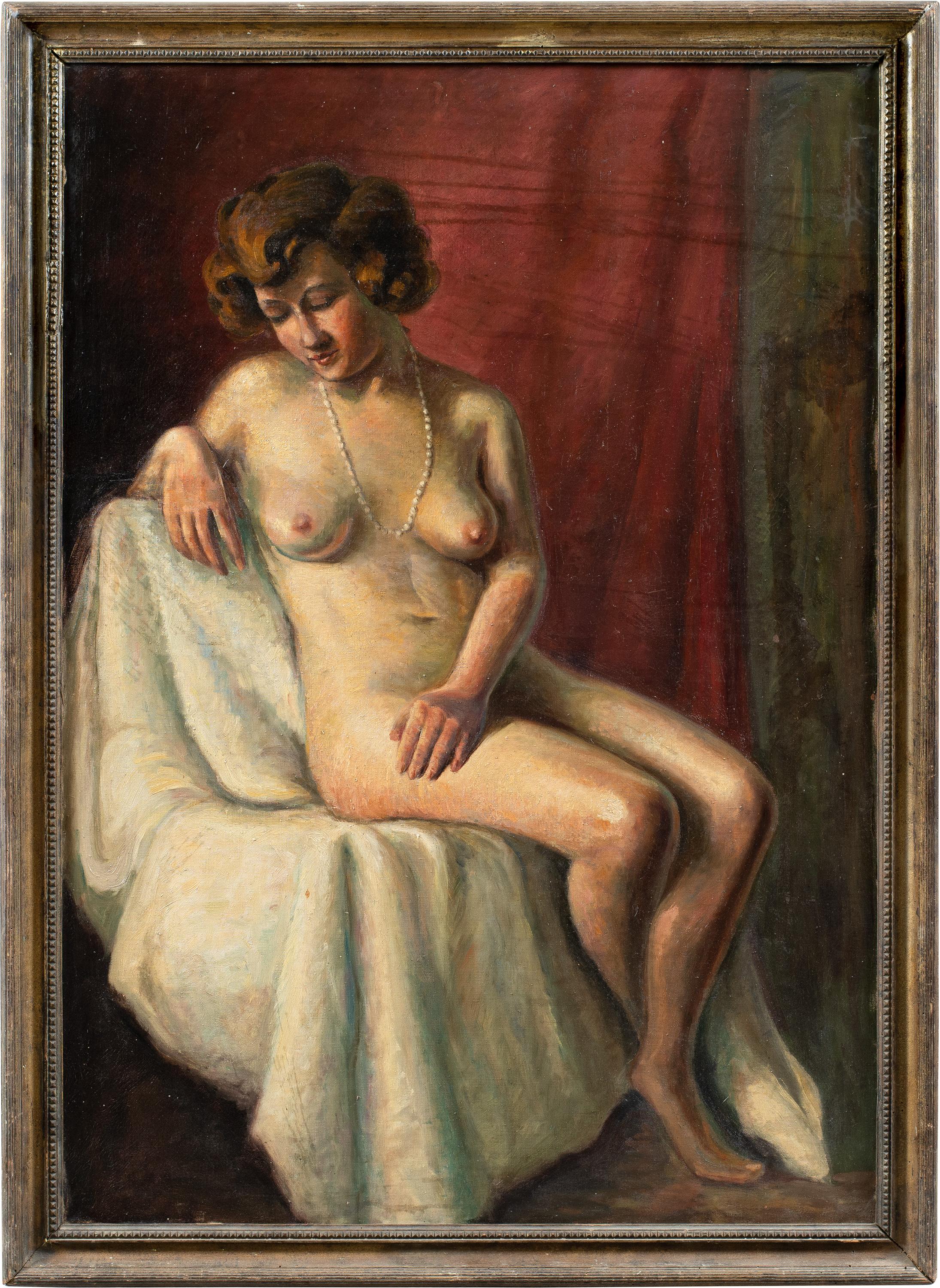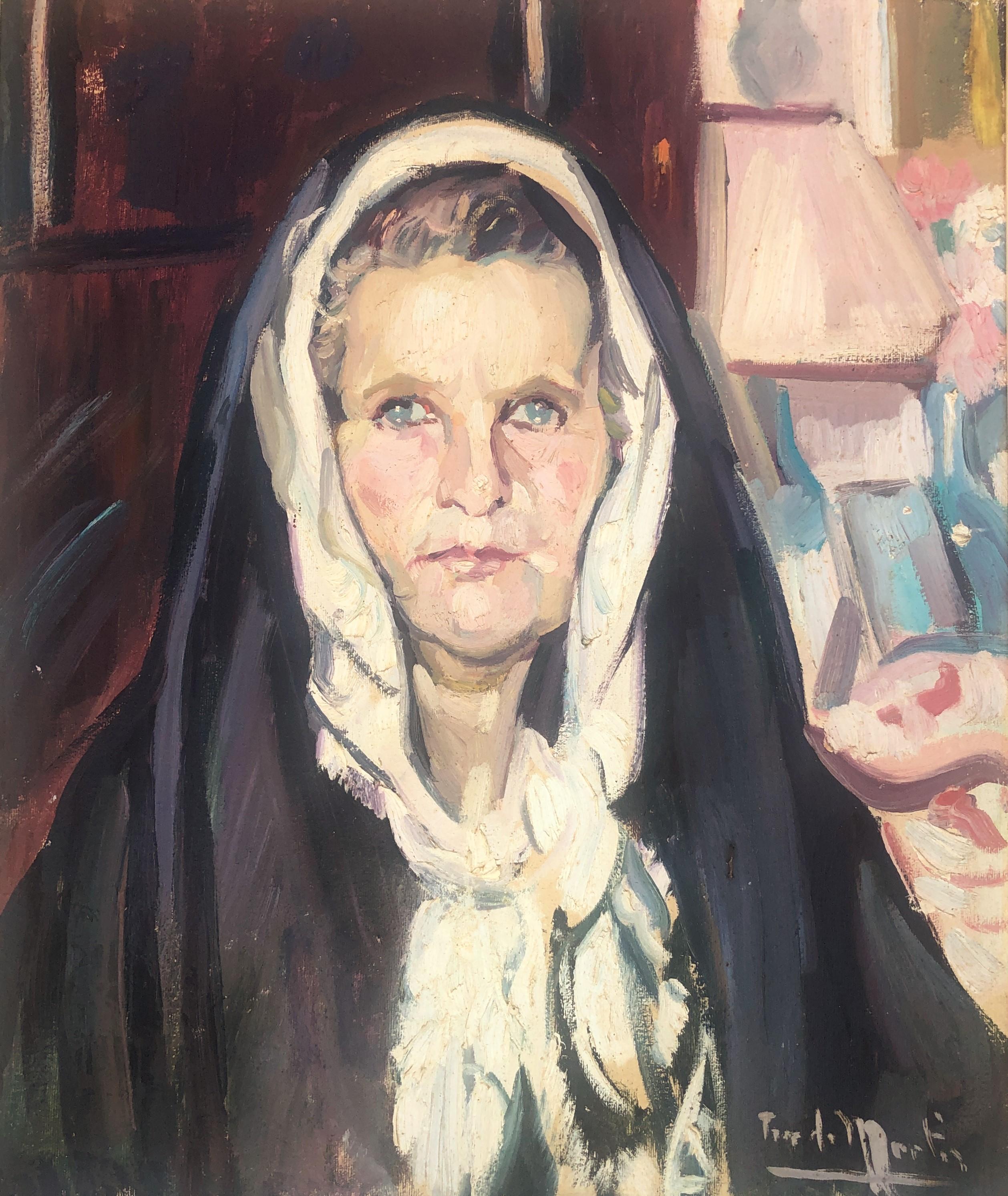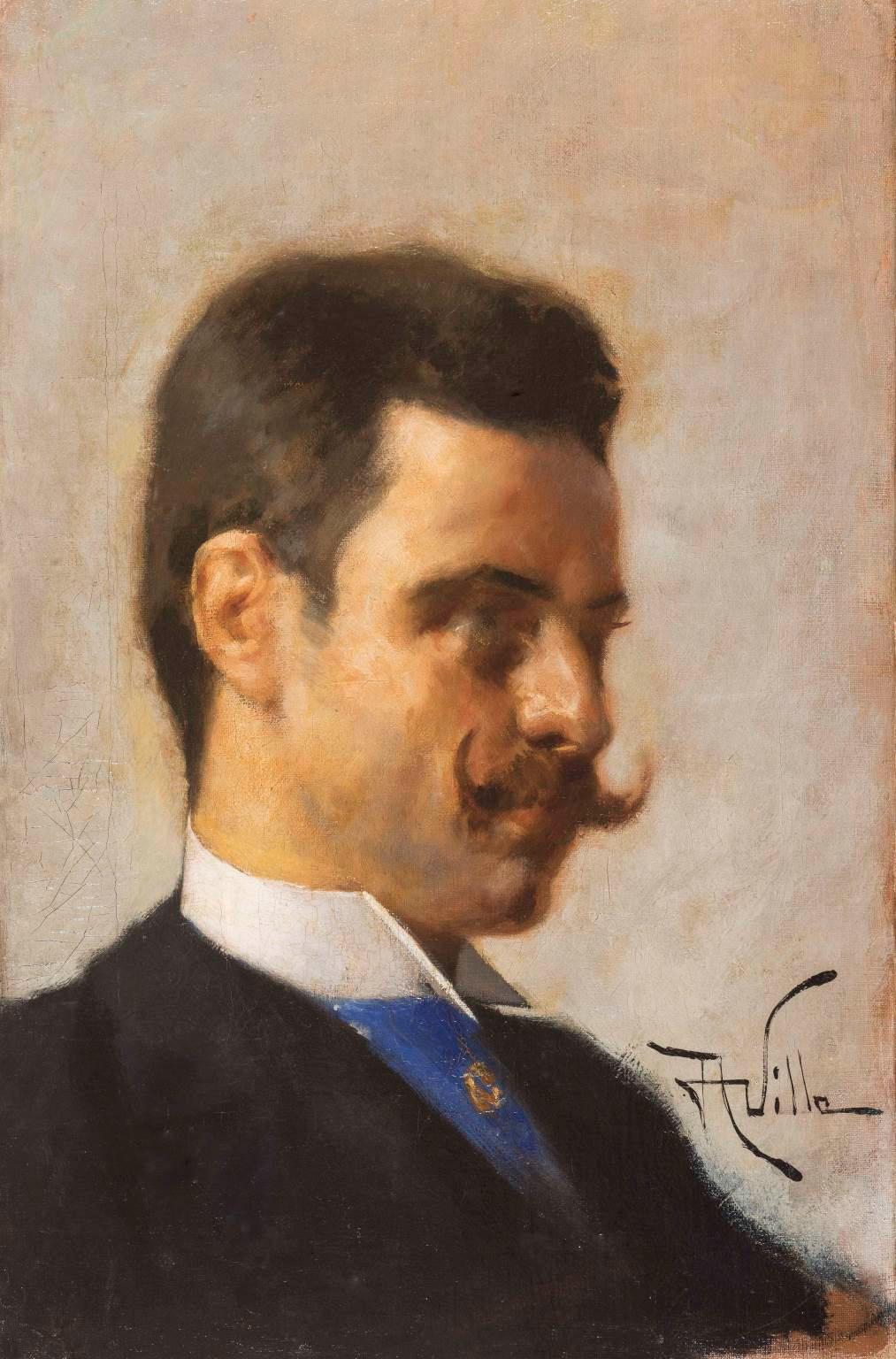Items Similar to Portrait of the painter Louis Degallaix (1877-1951), 1910
Want more images or videos?
Request additional images or videos from the seller
1 of 9
Henri Bouché-LeclercqPortrait of the painter Louis Degallaix (1877-1951), 19101910
1910
About the Item
Henri BOUCHÉ-LECLERCQ (1878-1946)
Portrait of the painter Louis Degallaix (1877-1951), 1910
Oil on canvas
Signed, dated “1910” and dedicated “à mon ami Degallaix” lower right
55 x 46 cm
Son of Auguste Bouché- Leclercq (1842-1923), a historian specializing in Greek and Roman antiquity and author of numerous publications, Henri Bouché- Leclercq was born in Paris in 1878. He trained at the École des Beaux-Arts with Joseph- Paul Blanc and Léon Bonnat before setting up his own studio in the Montparnasse district, at 89 rue de Vaugirard.
Henri Bouché-Leclercq painted an oil portrait of the philosopher Émile Boutroux, which was mentioned by the critic Louis Vauxcelles in his accounts of the 1906 Salon. He became a member of the Salon des artistes français and received a silver medal in 1933. In 1937, he was a member of the jury for the Universal Exhibition held in Paris. He was also curator at the Jacquemart-André Museum.
Not only a painter, Henri Bouché-Leclercq is also a recognized illustrator. He illustrated Paul Verlaine's Poèmes saturniens for Albert Meissen in 1914 and collaborated with Auguste Leroux in the illustration of Sapho, mœurs parisiennes by Alphonse Daudet for the Librairie des amateurs in 1925.
The work we propose is a portrait of the painter Louis Degallaix (1877-1951). This painter, who also frequented the studio of Léon Bonnat, distinguished himself in particular in the painting of flowers and landscapes. Henri Bouché-Leclercq realized his portrait in 1910, the same year that Louis Degallaix exhibited at the Georges Petit gallery (March 1910). We know of another portrait of the artist painted ten years later by the painter Eugène Ullman (ill.1).
The artist uses the pictorial technique of grisaille by using several shades of the same color: brown. This monochrome treatment through a sepia cameo is reminiscent of the famous portraits painted around 1900 by Eugène Carrière (1840-1906) (ill.2). It allows a perfect fading of the shadows and lights.
- Creator:Henri Bouché-Leclercq (1878 - 1946, French)
- Creation Year:1910
- Dimensions:Height: 21.66 in (55 cm)Width: 18.12 in (46 cm)
- More Editions & Sizes:Original workPrice: $1,753
- Medium:
- Movement & Style:
- Period:
- Condition:Sold without frame.
- Gallery Location:PARIS, FR
- Reference Number:1stDibs: LU2661213248102
About the Seller
5.0
Vetted Seller
These experienced sellers undergo a comprehensive evaluation by our team of in-house experts.
Established in 2018
1stDibs seller since 2023
- ShippingRetrieving quote...Ships From: PARIS, France
- Return PolicyA return for this item may be initiated within 14 days of delivery.
More From This SellerView All
- Bilboquet player, 1879Located in PARIS, FRAfter an initial training at the Toulouse School of Fine Arts, Jules-Arsène Garnier joined the Paris School of Fine Arts in 1867 in Jean-Léon Gérôme's studio. As an academic artist, ...Category
1870s Figurative Paintings
MaterialsCanvas, Oil
- Portrait of a woman with a toothache, circa 1900, oil on canvasLocated in PARIS, FRJulien-Auguste HERVÉ (1854-1932) Toothache, circa 1900 Oil on canvas Signed "JULIEN HERVE" and dated lower right 61.5 x 50 cm Born in 1854 in Basse-Indre, Loire-Atlantique, Julien-A...Category
Early 20th Century Portrait Paintings
MaterialsOil
- Portrait of a woman, oil on panelBy Jean BouchaudLocated in PARIS, FRJean BOUCHAUD (1891-1977) Portrait of a woman Oil on panel Signed “J Bouchaud” lower right Dimensions of the work without frame: 23.5 x 18.5 cm A native of the Loire-Atlantique reg...Category
Early 20th Century Portrait Paintings
MaterialsOil
- Paris, Saint-Martin canal, c. 1989, oil on canvasLocated in PARIS, FREmilio Trad (né en 1953) Paris, Saint-Martin canal, c. 1989 Oil on canvas Signed lower right 25,5 x 31,5 inch Emilio Trad, an artist of Lebanese origin bo...Category
1980s Landscape Paintings
MaterialsOil, Canvas
- Poetry of the bird, surrealist drawing, 1948Located in PARIS, FRJoséphine Beaudouin (1909-2005) Poetry of the Bird, surrealist painting, 1948 Oil on canvas Signed "Joséphine Beaudouin" and dated "1948" lower left 13,7 x 10,6 inch Born in Albi in 1909, Josephine Beaudouin (née Cals) showed an early interest in drawing. At the age of twelve, she moved to Paris where her mother, Jeanne Ramel-Cals, ran a literary salon that was frequented by art world figures such as Ambroise Vollard. In 1925, while her first drawings appeared in the magazine Crapouillot, the young artist entered the School of Decorative Arts where she studied fresco painting. She married the architect Eugène Beaudouin in 1928, with whom she traveled throughout Europe. Beaudouin, a member of the Académie des Beaux-Arts, designed a series of buildings that were precursors of modern architecture in France (Clichy, Maison du Peuple; Antony, Résidence universitaire Jean Zay). Josephine Beaudouin exhibited at the Salon des Indépendants, the Salon des Tuileries, the Salon d'Automne and the Salon des Artistes Décorateurs. The work of the one that Jean Cocteau described as "bewitching" is full of mystery. Her work bears the stamp of an extraordinary personality. Indeed, Josephine Beaudouin developed a penchant for dreams at a very early age and took refuge in the works illustrated by Gustave Doré. Her technical virtuosity and overflowing imagination were praised by the critics of her time who unanimously greeted her Marmorées (ill.1). Named by René Barotte, these are paintings made on marble slabs from 1955. The artist exploits the infinite resources of the veins of this support which inspires him poetic compositions with unusual subjects. Marked by surrealism, she returns to the fantastic by delivering a prodigious creation of the mind made of dreamed cities and trompe-l'oeil. The 1948 painting that we propose probably represents a red-billed chough. The bird is a recurring theme in the work of Josephine Beaudouin, as in her life. An avid ornithologist, she kept an aviary in her Parisian home where many island birds were kept. She also built up a collection of stuffed birds. Still on this theme, the writer Claude Aveline (1901-1992), author of the poem L'Oiseau-Qui-N'Existe-Pas, invited several visual artists to freely interpret what this bird could be. The first series of works was produced between 1956 and 1963. In 1957, Joséphine Beaudouin delivered a work with a pen of great finesse, now preserved at the Centre Pompidou (ill.2). Several renowned artists also responded to the invitation of the poet such as Jean Cocteau and Ossip Zadkine. The precision of the graphics of our painting testifies to an attentive observation of the anatomy of the birds. The artist paints with great delicacy: the technique is impeccable, the drawing is careful, the material is smooth, the details are represented with great finesse and mastery. Bibliography : Fernand Pouillon...Category
1940s Surrealist Figurative Paintings
MaterialsOil, Canvas
- Jean-Paul Pichon-Martin, Chickens, circa 1995, Oil on canvasLocated in PARIS, FRJean-Paul PICHON-MARTIN (1948-2018) Chickens, circa 1995 Oil on canvas Signed 3PM” lower right Signed on the back 92 x 73 cmCategory
1990s Animal Paintings
MaterialsOil
You May Also Like
- Frans Van Holder, 1881 - 1919, Belgian, 'Portrait Of A Young Woman In White'Located in Bruges, BEFrans Van Holder Ixelles 1881 – 1919 Geneva Belgian Painter 'Portrait of a Young Woman in White – The Artist’s Wife' Signature: Signed top left and dated 1906 Medium: Oil on canvas Dimensions: diameter: image size 96 cm, frame size 120,50 cm Biography: Van Holder Frans, born in Brussels in 1881, emerged as a prominent post-Impressionist painter during the Belle Epoque and Art Nouveau era. Initially a painter-decorator in his father’s workshop, he contributed to the adornment of Brussels’ bourgeoisie interiors, setting the stage for his alignment with the Art Nouveau movement. Van Holder studied under Alfred Cluysenaar at the Saint-Gilles Academy. His artistic evolution embraced Impressionist principles, influenced by luminosity proponents like Manet and Pissarro. After formal training at the Sint-Gillis Academy and travels through Spain, Italy, and Switzerland, Van Holder returned to Brussels in 1905, joining the esteemed ‘Pour l’Art’ association. Rejecting theoretical constraints, he prioritized harmony in his art, viewing color as a musical composition requiring rhythm and balance. Van Holder’s mastery extended to intimate post-impressionist portraits, notably capturing the Brussels aristocracy like the Wolfers family...Category
Early 20th Century Art Nouveau Portrait Paintings
MaterialsCanvas, Oil
- Louise Abbéma, 1853 – 1927, French Painter, 'Lady in Paris on a Winter Day'By Louise AbbemaLocated in Bruges, BEAbbéma Louise Étampes 1853 – 1927 Paris French Painter 'Lady in Paris on a Winter Day' Signature: Signed lower middle right Medium: Oil on canvas Dimensions: Image size 100 x 120 cm, frame size 112 x 132 cm Biography: Louise Abbéma, a prominent French artist of the Belle Époque, was born on October 30, 1853, in Étampes, Essonne, France. She hailed from a wealthy Parisian family with strong connections to the local artistic community. Her family’s artistic ties ran deep, as her great-grandmother was the renowned actress Louise Contat. From a young age, Abbéma exhibited a talent for painting and began her artistic journey in her early teens. She received formal training under the guidance of notable artists of her time, such as Charles Joshua Chaplin, Jean-Jacques Henner, and Carolus-Duran. Her talent and dedication bore fruit when, at the age of 23, she painted a portrait of the legendary actress Sarah Bernhardt, who became both a lifelong friend and, speculatively, a romantic partner. Abbéma’s artistic endeavors extended far beyond portraiture. She lent her creative touch to the embellishment of various iconic Parisian landmarks. Her panels and murals graced the Paris Town Hall, the Paris Opera House, numerous theaters (including the aptly named “Théâtre Sarah Bernhardt”), and even the “Palace of the Colonial Governor” in Dakar, Senegal. Her unique style combined academic and impressionistic elements, characterized by the use of light and rapid brushstrokes. Recognition continued to find Abbéma, and she became a regular exhibitor at the prestigious Paris Salon, earning an honorable mention for her work in 1881. She also had the distinction of having her art displayed at the Women’s Building during the 1893 World Columbian Exposition in Chicago. Moreover, a bust of Abbéma sculpted by Sarah Bernhardt was showcased at the exposition. Abbéma’s artistic repertoire was diverse, encompassing oil portraits and watercolors. Her work often bore the influence of Chinese and Japanese painters, as well as contemporary masters like Édouard Manet. Flowers were a recurring motif in her creations. Some of her most celebrated works include “The Seasons,” “April Morning,” “Place de la Concorde,” “Among the Flowers,” “Winter,” and portraits of prominent individuals such as actress Jeanne Samary, Emperor Dom Pedro II...Category
Late 19th Century Art Nouveau Portrait Paintings
MaterialsCanvas, Oil
- French nudes painter - 20th century figure painting - Oil on canvas ParisLocated in Varmo, ITFrench painter (early 20th century) - Female nude. 100 x 70 cm without frame, 109 x 79 cm with frame. Antique oil painting on canvas, in a gilded wooden frame (some cracks). Condi...Category
1920s Art Nouveau Nude Paintings
MaterialsCanvas, Oil
- Suspicious Mr. J (art nouveau grey monochrome vintage portrait nostalgia man)By Rudolf KosowLocated in Quebec, Quebeckeywords; surrealism, portrait, oil painting, earth tones, figurative painting, strangeness, contemporary surrealistic, unsettling, contemporary figurative painting, dreams, symbolic...Category
2010s Jugendstil Figurative Paintings
MaterialsCanvas, Oil
- Ibiza woman Spain spanish oil on canvas painting portraitBy Mariano Tur de MontisLocated in Barcelona, BarcelonaFrame size 83x73 cm. Mariano Tur de Montis (Ibiza 1904 -1994). Son of the Ibizan general Don Juan Tur y Palau, of an old patrician family on the island, and of Doña Cristina de Montis and von der Klee. Ibiza painter who felt great admiration for the Spanish classics and the influence of Central European painting of the late 18th and early 19th centuries, and especially that of the painter Manuel Benedito. He received multiple praises in his various artistic exhibitions not only in Ibiza, but also in Palma de Mallorca, Mahón, Barcelona, Madrid and in European capitals such as London or Paris. When he was only fifteen, he decided to go to meet Sorolla - when he was painting "The Smugglers" in the vicinity of his family mansion - to find out what opinion he deserved on the first portrait he had made of his mother. A few years later, and undoubtedly encouraged by the praiseworthy response received, he was already successfully overcoming the successive sieves of artistic criticism, until he stood out with the “subtle and aristocratic” style that characterized him, in such relevant competitions as the National Exhibition de Bellas Artes or at the Paris Salon. Delving into his biography it is possible to recognize the main factors that would converge in this rapid and justified progression: the very cultural and artistic environment that surrounded him since his birth. The specific preparation with which his refined mother channeled his innate qualities and marked sensitivity. As well as, and above all, his own need to create beauty. Despite a brilliant degree in Law, he attended the Sant Jordi Academy of Fine Arts in Barcelona, complementing his training in Rome, Florence and Paris. At the early date of 1925, the local press was pleased to transcribe the reviews of his exhibition in the Galerías Layetanas of Barcelona, and in which the acquisition of one of his works "Frivolities" for the Museum of Art took place. Modern of Palermo (Sicily). After participating in 1926 in the Autumn Salon of Palma de Mallorca, together with Narcís Puget Viñas, and in 1929 in the Permanent Exhibition of Levante Art, one of his emblematic satisfactions would arrive: the praises that King Alfonso XIII himself dedicated to the stop before his painting Céfora, a painting in which his sister Guadalupe Tur de Montis was the model, during the National Exhibition of Fine Arts, held in Madrid. Oil that also deserved attention in the prestigious magazine La Esfera, which dedicated the cover of its number 20 of July 5, 1930, or the French magazine La Revue Moderne. In the magazine Arte y Hogar- in its number 56, the Marqués de Lozoya Director General of Fine Arts wrote a nice eulogy of the painter and his work in the photographic report dedicated to the beautiful and elegant Casa de los Tur de Ibiza. It was precisely in 1930, when Tur de Montis began to interact amicably and professionally, with a select group of painters, both Spanish (Pla, Rigoberto Soler, Amadeo Roca and Laureano Barrau...Category
1980s Art Nouveau Portrait Paintings
MaterialsOil, Canvas
- Signed Aleardo Villa Male Moustache Portrait 1890 circa oil canvasBy Aleardo VillaLocated in Florence, ITThe painting is signed on the right side "AVILLA". Aleardo Villa was a pupil of Giuseppe Bertini and Bartolomeo Giuliano and he graduated at the Fine Arts Academy of Brera, becoming ...Category
Late 19th Century Art Nouveau Portrait Paintings
MaterialsCanvas, Oil




